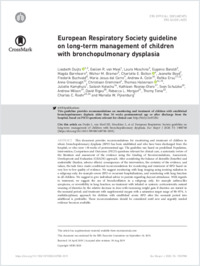European Respiratory Society guideline on long-term management of children with bronchopulmonary dysplasia.
- Duijts L Dept of Pediatrics, Division of Respiratory Medicine and Allergology, Erasmus MC, University Medical Center Rotterdam, Rotterdam, The Netherlands l.duijts@erasmusmc.nl.
- van Meel ER Dept of Pediatrics, Division of Respiratory Medicine and Allergology, Erasmus MC, University Medical Center Rotterdam, Rotterdam, The Netherlands.
- Moschino L Dept of Women's and Children's Health, University of Padua, Padua, Italy.
- Baraldi E Dept of Women's and Children's Health, University of Padua, Padua, Italy.
- Barnhoorn M Lung Foundation Netherlands, Amersfoort, The Netherlands.
- Bramer WM Medical Library, Erasmus MC, University Medical Center Rotterdam, Rotterdam, The Netherlands.
- Bolton CE NIHR Nottingham BRC Respiratory Theme and Division of Respiratory Medicine, University of Nottingham, Nottingham, UK.
- Boyd J European Lung Foundation (ELF), Sheffield, UK.
- Buchvald F Pediatric Pulmonary Service, DBLC, Rigshospitalet, Copenhagen, Denmark.
- Del Cerro MJ Pediatric Cardiology, Ramón y Cajal University Hospital, Madrid, Spain.
- Colin AA Division of Pediatric Pulmonology, Miller School of Medicine, University of Miami, Miami, FL, USA.
- Ersu R Division of Respirology, Marmara University Istanbul, Istanbul, Turkey.
- Greenough A Women and Children's Health, School of Life Course Sciences, Faculty of Life Sciences and Medicine, King's College London, London, UK.
- Gremmen C Lung Foundation Netherlands, Amersfoort, The Netherlands.
- Halvorsen T Dept of Pediatrics, Haukeland University Hospital, Bergen, Norway.
- Kamphuis J European Lung Foundation (ELF), Sheffield, UK.
- Kotecha S Dept of Child Health, School of Medicine, Cardiff University, Cardiff, UK.
- Rooney-Otero K Division of Hospital Medicine, Nemours Children's Hospital, Orlando, FL, USA.
- Schulzke S Dept of Neonatology, University Children's Hospital Basel UKBB, Basel, Switzerland.
- Wilson A Dept of Respiratory and Sleep Medicine, Princess Margaret Hospital for Children, Perth, Australia.
- Rigau D Iberoamerican Cochrane Centre, Barcelona, Spain.
- Morgan RL Dept of Health Research Methods, Evidence and Impact, McMaster University, Hamilton, ON, Canada.
- Tonia T Insitute of Social and Preventive Medicine, University of Bern, Bern, Switzerland.
- Roehr CC Dept of Paediatrics, Medical Sciences Division, University of Oxford, Oxford, UK.
- Pijnenburg MW Dept of Pediatrics, Division of Respiratory Medicine and Allergology, Erasmus MC, University Medical Center Rotterdam, Rotterdam, The Netherlands.
- 2019-09-28
Published in:
- The European respiratory journal. - 2020
English
This document provides recommendations for monitoring and treatment of children in whom bronchopulmonary dysplasia (BPD) has been established and who have been discharged from the hospital, or who were >36 weeks of postmenstrual age. The guideline was based on predefined Population, Intervention, Comparison and Outcomes (PICO) questions relevant for clinical care, a systematic review of the literature and assessment of the evidence using the Grading of Recommendations, Assessment, Development and Evaluation (GRADE) approach. After considering the balance of desirable (benefits) and undesirable (burden, adverse effects) consequences of the intervention, the certainty of the evidence, and values, the task force made conditional recommendations for monitoring and treatment of BPD based on very low to low quality of evidence. We suggest monitoring with lung imaging using ionising radiation in a subgroup only, for example severe BPD or recurrent hospitalisations, and monitoring with lung function in all children. We suggest to give individual advice to parents regarding daycare attendance. With regards to treatment, we suggest the use of bronchodilators in a subgroup only, for example asthma-like symptoms, or reversibility in lung function; no treatment with inhaled or systemic corticosteroids; natural weaning of diuretics by the relative decrease in dose with increasing weight gain if diuretics are started in the neonatal period; and treatment with supplemental oxygen with a saturation target range of 90-95%. A multidisciplinary approach for children with established severe BPD after the neonatal period into adulthood is preferable. These recommendations should be considered until new and urgently needed evidence becomes available.
- Language
-
- English
- Open access status
- bronze
- Identifiers
-
- DOI 10.1183/13993003.00788-2019
- PMID 31558663
- Persistent URL
- https://folia.unifr.ch/global/documents/293041
Statistics
Document views: 13
File downloads:
- fulltext.pdf: 0
